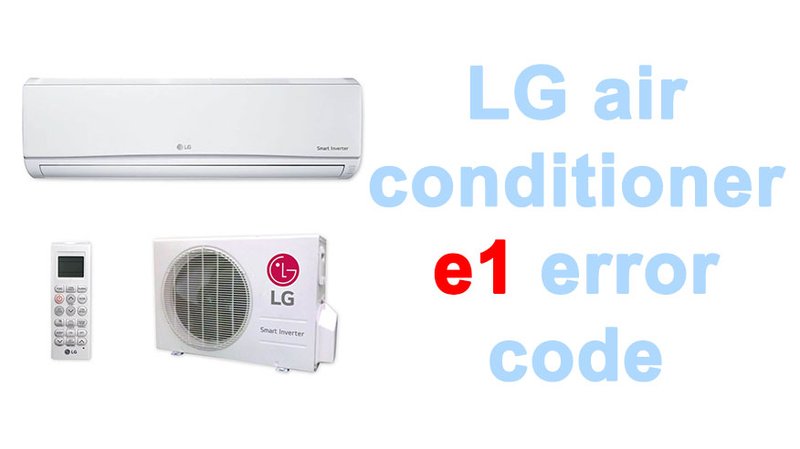
Imagine your air conditioner as a team of workers in a factory, all performing specific tasks to keep your home comfortable and cool. When everything’s running smoothly, you’re blissfully unaware of their toil. But the moment something goes awry, like the E1 error, it’s like one of those workers holding up a red flag, signaling that something needs attention. So, what does that flag mean, and more importantly, how can you resolve it? Let’s dive into that.
Understanding the E1 Error Code
The E1 error code on your LG air conditioner is a signal that something isn’t quite right. Consider it the appliance’s way of saying, “Hey, I need a little help here.” Typically, this code indicates an issue with the unit’s temperature sensors or circuitry. Think of these sensors as the air conditioner’s “eyes,” keeping track of the internal and ambient temperatures to ensure everything is operating optimally.
When these sensors detect something out of the ordinary, like a temperature that’s too high or low compared to what you’ve set, they trigger the E1 code to bring it to your attention. Sometimes, the problem might be as simple as a loose connection or a dirty sensor, similar to smudged glasses that make it hard to see clearly. In other cases, it might indicate a more serious malfunction in the system’s electronics.
But don’t worry, there’s a silver lining! Understanding the common causes of this error can set you on the path to a quick resolution. In many cases, with a bit of troubleshooting, you can get your AC back up and running without needing to call in the experts. Let’s break down the common causes and how you can address them.
Common Causes of the E1 Error Code
Faulty Temperature Sensor
One of the most frequent culprits behind the E1 error is a faulty temperature sensor. Think of these sensors as the AC’s sensory nerve endings, responsible for keeping the temperature just right. If they’re on the fritz, your AC might struggle to maintain the desired temperature, just like trying to navigate a ship with a broken compass.
A temperature sensor can malfunction due to wear and tear over time, dirt accumulation, or even a loose connection. If you’re facing an E1 error, checking the sensor should be your first port of call. Examine it for any visible dirt or loose wires, and gently clean the sensor if needed. This simple act, akin to wiping a smudge off your reading glasses, might just clear up the issue.
If cleaning doesn’t help, the sensor might need replacement. While some tech-savvy folks might feel comfortable doing this themselves, others might prefer calling a professional. Either way, a sensor replacement isn’t too daunting and can often resolve the error without burning a hole in your pocket.
Issues with the Control Board
The control board in your air conditioner is like the brain of the operation. It processes information and sends signals to different parts of the system to keep everything running smoothly. If the control board runs into trouble, it might incorrectly register temperatures or commands, resulting in an E1 error code popping up.
Control board issues can arise from electrical surges, component failures, or simply age. If you’ve ruled out issues with the temperature sensor, the control board might be the next suspect. Checking for visible damage or burnt areas on the board could give you a clue about its condition.
Unfortunately, fixing or replacing a control board is usually best left to professionals unless you have a strong understanding of electronics. If this is the root cause of your E1 troubles, contacting a qualified technician is the wisest course of action to prevent further complications.
Wiring and Connection Problems
Wiring and connections are like the veins of your AC unit, delivering the electrical signals needed to keep it running. Over time, these connections can become loose, corroded, or damaged, sending erroneous signals that could trigger the E1 error code.
Inspect your air conditioner’s wiring to ensure everything’s securely connected. A loose wire is like a wobbly doorknob—often easily fixed with a little tightening. Just make sure to turn off the power before you start fiddling around inside your AC.
If loose connections aren’t the issue, damaged or corroded wires might need to be replaced. While this might sound intimidating, it’s a straightforward task for a technician. Addressing these wiring issues not only resolves the E1 code but also extends your unit’s lifespan by preventing potential future glitches.
How to Prevent the E1 Error Code
Nobody likes dealing with unexpected hiccups, especially when it comes to home appliances. So, how can you keep the E1 error at bay? Regular maintenance is your best ally here. Just like how you regularly service your car to prevent breakdowns, your air conditioner also benefits from periodic check-ups.
Ensure that filters are clean, the unit is dust-free, and all connections are secure. Sometimes, a simple cleaning session does wonders, just as a refreshing shower does for us after a long day. Keeping an eye on the overall condition of your AC can help spot potential issues before they escalate into error codes.
If you’re unsure about performing these checks yourself, scheduling annual maintenance with a professional can be a wise investment. Think of it as a small price to pay for reliable, year-round comfort. By taking these preventive steps, you’re giving your air conditioner the best chance to serve you diligently, error-free, for years to come.
When you see the E1 error on your LG air conditioner, don’t panic. With a little insight and a proactive approach, you can tackle this issue and restore your cool in no time.